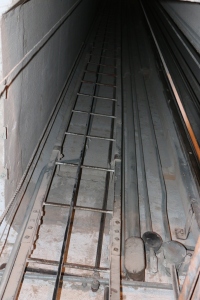
By Ronald Ahrens
By 1945, some six years after its first reinforced-concrete elevator, Tillotson Construction Co., of Omaha, had completed 15 such jobs, with a hiatus in 1942 and 1943 because of wartime materials shortages.
 The size of these elevators ranged from tiny, namely, 37,550 bushels at Peterson, Iowa, to quite enormous, 350,000 bushels at Farnsworth, Tex. Where’s that? Looking again at the map, I drove right through Farnsworth on Route 15 about 10 miles before reaching Booker. Somehow, when planning this road trip, I missed Farnsworth in the company’s construction record. So I got nothing from that early giant–a deflating thing weeks after the fact.
The size of these elevators ranged from tiny, namely, 37,550 bushels at Peterson, Iowa, to quite enormous, 350,000 bushels at Farnsworth, Tex. Where’s that? Looking again at the map, I drove right through Farnsworth on Route 15 about 10 miles before reaching Booker. Somehow, when planning this road trip, I missed Farnsworth in the company’s construction record. So I got nothing from that early giant–a deflating thing weeks after the fact.
Six of the 15 earliest elevators had less than a 100,000-bushel capacity. The Booker elevator was on the larger side at 216,000 bushels. As previously mentioned, it followed a plan (with some revisions) first established in 1941 at Medford, Okla.
 Booker was capable of holding 6,480 tons of grain. Fully loaded, the whole shebang weighed 10,798 tons. For the record, a Boeing 747-8 weighs as much as 970,000 pounds, or 458 tons, at takeoff. So a whole lot of big airplanes are represented in the elevator’s maximum gross weight.
Booker was capable of holding 6,480 tons of grain. Fully loaded, the whole shebang weighed 10,798 tons. For the record, a Boeing 747-8 weighs as much as 970,000 pounds, or 458 tons, at takeoff. So a whole lot of big airplanes are represented in the elevator’s maximum gross weight.
The 21-inch-thick main slab was laid over a pit measuring 13 feet 9 inches in depth. (Farnsworth’s pit plunged down 26 feet!) Booker’s capacious rectangular headhouse was 21.5 feet wide, 48.5 feet long, and 33 feet high. The pulley centers were 158.16 feet apart.

Wondering if this ladder next to the man lift goes all the way to the headhouse.
The single leg comprised a boot pulley of 24 x 14 x 3 3/16 inches and a head pulley of 72 x 14 x 3 15/16 inches. In just a couple of years it was typical for boot and head to be the same 72-inch diameter.
The pulleys turned at 42 rpm thanks to a 40-horse Howell motor made in Howell, Mich. The 14-inch, six-ply Calumet belt with 12 x 6-inch cups at nine-inch intervals had a theoretical capacity (according to the rating of the cups’ manufacturer) of lifting 7,500 bushels per hour out of the pit. Actual capacity ran 6,000 bushels per hour. For the day, it was a high-performance leg: the companion elevator built the same year in Follett, which had pulley centers stretched 180.58 feet apart, realized actual of 4,100 bushels per hour.
A 2-hp motor moved the man lift up to the headhouse and back. The truck lift used the same 7-hp Ehrsam motor that Tillotson liked for this purpose. And a 3-hp motor operated the dust collection system’s fan.
All of 73 years after its construction, the Booker behemoth was wide awake on the morning of April 18, 2018, still doing its job.
[…] well as Thomas, Burlington, Cherokee, and Lamont, Okla., Elkhart, Kan., and in neighboring Booker, Tex.–the Follett elevator sat on a 21-inch-thick slab covering an area 51 x 65.5 feet. All are […]